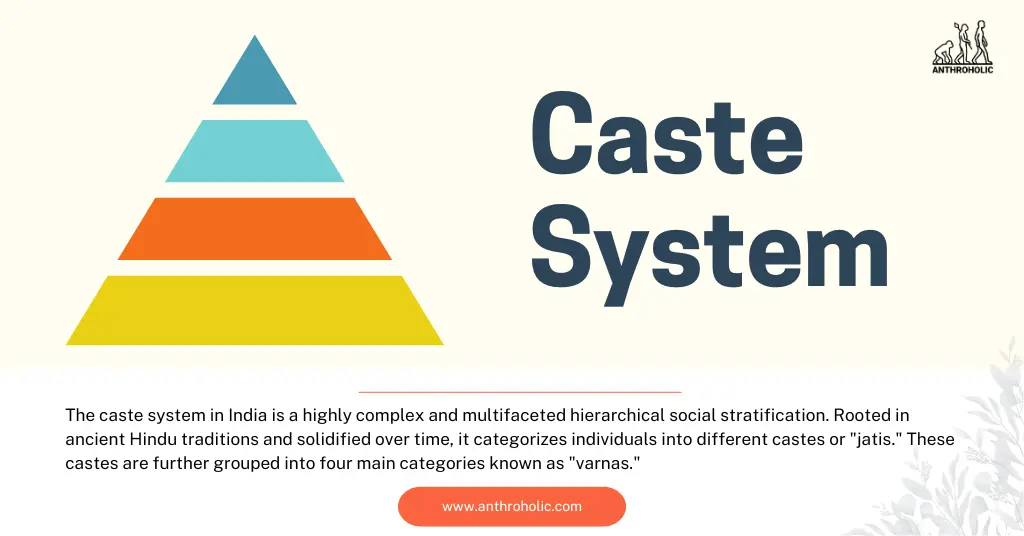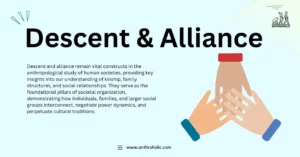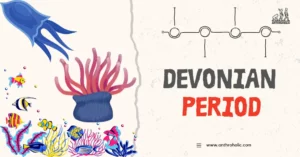+91-7303290503, +91-9557169661 | MON to SUN 10:00 AM - 6:00 PM
The Indian Caste System: A Comprehensive Anthropological Analysis
“Caste is not a physical object like a wall of bricks or a line of barbed wire which prevents the Hindus from co-mingling… Caste is a notion; it is a state of the mind.” — B.R. Ambedkar
This profound statement from B.R. Ambedkar, a chief architect of the Indian Constitution and its most trenchant critic of caste, captures the enduring enigma of the subject. The caste system in India is far more than a simple method of social organization; it is a deeply ingrained ideology, a paradigmatic ethnographic instance of caste and social stratification that has structured the lives of people on the subcontinent for over 3,000 years. As a hereditary system that segregates people into fixed social groups based on notions of purity and contamination, it impacts nearly a fifth of the world’s population, primarily in South Asia.

For anthropology, the caste system is a subject of central importance. It challenges universalist theories of social stratification, provides a unique case study of the interplay between religion, kinship, and power, and serves as a critical ground for debates on cultural relativism, social justice, and human rights. This article deconstructs the Indian caste system by tracing its historical and scriptural origins, examining its core structural features, analyzing it through key anthropological and sociological lenses, and assessing its profound and persistent impact on contemporary Indian society, politics, and economy. It navigates the crucial distinction between the ‘book-view’ of scriptural ideals and the ‘field-view’ of lived reality.
Foundations of the Caste System: Varna and Jati
Understanding the caste system requires distinguishing between two related but distinct concepts: varna and jati. While often used interchangeably, they represent different levels of analysis—the theoretical ideal versus the practical reality.
The Varna Ideology (The ‘Book-View’)
The varna system is the ancient, four-fold hierarchical division described in Hindu scriptures as the ideal social order. This framework, whose name in Sanskrit can mean “color” or “class,” divides society into four functional categories:
- Brahmins: Priests, scholars, and teachers, considered the highest in purity and status.
- Kshatriyas: Rulers, warriors, and administrators, tasked with protection and governance.
- Vaishyas: Merchants, traders, and farmers, responsible for commerce and agriculture.
- Shudras: Laborers, artisans, and service providers, who served the other three varnas.
The first three varnas – Brahmins, Kshatriyas, and Vaishyas, are known as the “twice-born” (dvija). This status is conferred upon males through a sacred initiation rite, granting them access to religious sacraments and sacred knowledge, a privilege denied to the “once-born” Shudras.
The Jati Reality (The ‘Field-View’)
While varna provides a broad, theoretical model, the lived reality of caste for most Indians is the jati system. The term jati, from the Sanskrit jāta (“born”), signifies a form of existence determined by birth. It is a system of thousands of distinct, localized, and primarily endogamous (marrying within the group) communities, each with its own customs and often linked to a traditional occupation. Estimates suggest there are as many as 2,500 to 3,000 jatis in each major linguistic region of India. The relationship between the two systems is complex; historically, jatis have often sought to improve their social standing by claiming a higher varna status, such as the Rajputs successfully claiming Kshatriya identity.
The Outcastes: Dalits and Adivasis
Historically situated outside the four-fold varna system are the Dalits (a self-chosen term meaning “broken” or “oppressed,” formerly known as “Untouchables”) and Adivasis (tribal communities). Dalits were assigned tasks considered ritually polluting, such as handling dead animals, tanning leather, or sanitation work. This association with pollution led to extreme forms of social ostracization, economic deprivation, and religious discrimination, making them victims of the practice of “untouchability”.
To clarify these foundational concepts, the following table provides a comparative framework.
Table 1: Varna vs. Jati: A Comparative Framework
| Feature | Varna System | Jati System |
| Origin | Scriptural, ideological (e.g., Rigveda) | Historical, regional, occupational, kinship-based |
| Number | Four (plus outcastes) | Thousands (approx. 2,500-3,000 per region) |
| Basis | Idealized functional division of society (guna and karma) | Hereditary, birth-based groups (ascribed status) |
| Scope | Pan-Indian theoretical model (‘book-view’) | Local/regional practical reality (‘field-view’) |
| Primary Rule | Dharma (prescribed duties for each varna) | Endogamy (marriage within the group) |
Scriptural and Historical Origins: Contested Narratives
The origins of the caste system are not a single event but a complex historical process. Various theories, from the divine to the socio-economic, attempt to explain its genesis.
The Divine Origin Theory
The most cited scriptural basis for the varna system is the Purusha Sukta, a hymn in the Rigveda. It describes the four varnas emerging from the sacrifice of a cosmic being, Purusha: the Brahmins from his mouth, Kshatriyas from his arms, Vaishyas from his thighs, and Shudras from his feet. This narrative serves as a powerful charter myth, providing divine sanction for a hierarchical social order. However, many scholars now contend that this verse was a later addition to the text, likely inserted to legitimize an already emerging social structure rather than create it. Later texts, particularly the Dharmashastras and the Manusmriti, moved beyond this embryonic ideal to prescribe highly schematic and rigid rules governing occupations, duties, and social interactions, cementing the Brahmins’ superior position.
Scholarly Theories of Origin
Several scholarly theories offer alternative explanations:
- Racial Theory: Popular during the colonial era, this theory proposed that fair-skinned Aryan invaders subjugated darker-skinned indigenous Dravidian populations, establishing caste as a form of racial hierarchy. The very word varna (“color”) was cited as evidence. This theory, however, is now largely contested by modern genetic and archaeological evidence that suggests more complex patterns of migration and cultural mixing.
- Occupational Theory: This sociological view argues that as ancient Indian society grew more complex, occupational guilds (shrenis) gradually crystallized into hereditary jatis. This explains the strong traditional link between many jati names and specific professions, such as Dhobi (washerman) or Lohar (blacksmith).
- Colonial Codification: A critical perspective argues that the British Raj played a pivotal role in transforming caste from a more fluid, regional system into the rigid, pan-Indian administrative category it is today. The British need to categorize and control the Indian population led them to use the census to formally classify and rank jatis. This act of “freezing” a dynamic social reality into administrative text solidified boundaries and hierarchies that may have previously been more negotiable and contested, giving modern caste its unyielding character.
Key Features of the Caste System: A Framework of Social Control
As a unique form of social stratification, the caste system is defined by a set of mutually reinforcing features, famously outlined by sociologist G.S. Ghurye.
- Segmental Division of Society: Society is fragmented into a multitude of distinct caste groups. Membership is determined by birth, and each segment functions as a “complete social world” with its own rules, with virtually no mobility between them.
- Hierarchy: These segments are arranged in a strict vertical order of superiority and inferiority, with Brahmins at the apex and Dalits at the base. This hierarchy governs access to power, resources, and social prestige.
- Restrictions on Social Interaction (Purity and Pollution): The core ideology of purity and pollution underpins the entire hierarchy and dictates social distance. This manifests in rules of commensality (restrictions on sharing food and drink), with upper castes traditionally refusing cooked food from lower castes, and in the physical segregation of living spaces and denial of access to common resources like wells and temples.
- Hereditary Occupation: Traditionally, each jati was associated with a specific occupation passed down through generations. While this has weakened, caste-based occupational patterns persist, especially in rural areas and for stigmatized jobs like manual scavenging.
- Endogamy: This is arguably the most fundamental and resilient feature. The rule of marrying within one’s own jati is the primary mechanism for maintaining caste boundaries and the notion of group “purity.” Historically, violating this rule resulted in severe punishment, including ostracism.
- Civil and Religious Disabilities: The system historically imposed severe disabilities on lower castes (e.g., denial of education, prohibition from entering temples) while granting privileges to upper castes. Informal enforcement of these norms often fell to Caste Panchayats, which acted as local governing bodies to punish transgressions.
These features do not exist in isolation but form an interlocking structure of control. Endogamy preserves the “purity” of the group, which justifies its position in the hierarchy. This hierarchy, in turn, legitimizes the unequal division of labor and the imposition of social disabilities. The system’s resilience lies in this holistic and self-perpetuating logic.
Sociological Lenses on Caste: Ghurye, Dumont, Srinivas, and Ambedkar
The study of caste has been shaped by several influential thinkers whose anthropological theories of caste offer distinct perspectives on its nature and functioning.
- G.S. Ghurye (The Indological/Descriptive View): Ghurye’s work, particularly Caste and Race in India, provides a foundational descriptive framework based on a synthesis of textual evidence and empirical observation. His six features (detailed above) remain a standard starting point for understanding the system’s structure, with a key emphasis on endogamy.
- Louis Dumont (The Structuralist/Ideological View): In his seminal work Homo Hierarchicus, Dumont argued that caste is not merely social stratification but a unique ideology founded on a single binary opposition: the pure and the impure. For Dumont, this religious principle encompasses all other aspects of the system. He famously posited a disjunction of status and power, where the Brahmin holds the highest ritual status (purity) but is temporally subordinate to the Kshatriya king (power). This separation is, for Dumont, the defining genius of the system.
- M.N. Srinivas (The Field-View/Dynamic View): Through intensive fieldwork, Srinivas challenged the static models of his predecessors. He introduced concepts that highlighted social mobility and change within the system. His theory of Sanskritization describes the process by which a lower caste adopts the customs and lifestyle of a higher caste to claim a higher position in the hierarchy over generations. His concept of the Dominant Caste showed how a group with numerical strength and land ownership could wield significant local power, challenging the ritual supremacy of Brahmins and highlighting the importance of secular factors.
- B.R. Ambedkar (The Emancipatory/Radical Critique): Ambedkar’s analysis in Annihilation of Caste is a political manifesto for liberation from the perspective of the oppressed. He argued that caste is not a “division of labour” but a “division of labourers,” an unnatural system that crushes human potential. He asserted that caste is the very essence of Hinduism, sanctioned by its scriptures, and thus cannot be reformed. His radical solution was the complete annihilation of caste through inter-marriage and the destruction of the religious notions upon which it is founded.
Table 2: Comparative Sociological and Political Perspectives on Caste
| Thinker | Core Argument | Key Concepts | Primary Focus | View on Change |
| G.S. Ghurye | Caste is a unique Indian phenomenon defined by six structural features, with endogamy being paramount. | Segmental Division, Hierarchy, Endogamy | Textual/Historical (Indological) | Descriptive; acknowledges change over time. |
| Louis Dumont | Caste is a holistic ideology based on the religious opposition of Pure and Impure, separating status from power. | Homo Hierarchicus, Purity/Pollution, Status vs. Power | Ideology/Structuralism | System is deeply ingrained and resistant to modernization. |
| M.N. Srinivas | Caste is a dynamic system with avenues for social mobility, influenced by local power structures. | Sanskritization, Dominant Caste | Empirical/Fieldwork | Change is possible within the hierarchical framework (positional change). |
| B.R. Ambedkar | Caste is a system of graded inequality, sanctioned by religion, that must be annihilated, not reformed. | Annihilation of Caste, Division of Labourers | Emancipatory/Political | Radical structural change requires destroying the religious foundations of caste. |
Voices of Resistance: Anti-Caste Movements and Their Legacies
The caste system has never been a site of passive acceptance; it has always been contested. Anti-caste movements have a long and rich history in India.
- Early Reformers: In the 19th and early 20th centuries, several powerful movements emerged. In Maharashtra, Jyotirao Phule founded the Satyashodhak Samaj (Truth-Seekers Society) in 1873 to educate and empower lower castes, radically reinterpreting history to build a counter-identity. In the south, E.V. Ramasamy (Periyar) led the Self-Respect Movement in Tamil Nadu, rejecting Brahmanical culture, while Sree Narayana Guru in Kerala challenged the Brahmin monopoly on priesthood with his famous slogan, “One Caste, One Religion, One God for Mankind”. The Vaikom Satyagraha (1924) in Kerala was a pivotal struggle for temple entry rights for untouchables.
- The Ambedkarite Revolution: B.R. Ambedkar’s efforts culminated in constitutional safeguards against discrimination, the founding of political parties to secure Dalit rights, and his final, symbolic act of leading a mass conversion to Buddhism in 1956, representing a definitive break from Hinduism.
- Post-Independence Movements: The Dalit Panthers, founded in Maharashtra in 1972, marked a new phase of resistance. Inspired by the Black Panther movement in the United States, this was a militant, radical movement of Dalit youth and writers who used confrontational literature and direct action to protest atrocities. They had a profound impact on forging a new, assertive Dalit consciousness and a powerful body of protest literature.
The trajectory of these movements reveals a significant shift. Early struggles often sought reform and inclusion within the Hindu fold, such as the right to enter temples. Later movements, culminating in Ambedkar’s conversion and the Panthers’ revolutionary rhetoric, reflect a growing disillusionment with internal reform, moving instead towards a radical rejection of the system and the creation of an independent, assertive identity.
Caste in Contemporary India: Persistence and Transformation
Modernization, democracy, and globalization have not annihilated caste but have instead given it new life and new forms. It has transformed from a primarily local, ritual-based hierarchy into a powerful, politicized identity marker that shapes access to economic resources and state power.
Caste and Politics
Caste is a central axis of Indian politics. Political parties meticulously calibrate caste combinations in candidate selection, and caste groups often vote as blocs, creating “vote banks”. The implementation of the Mandal Commission recommendations in 1990, which reserved 27% of government jobs for Other Backward Classes (OBCs), was a watershed moment. It politicized caste identity on a national scale and led to the rise of powerful regional, caste-based parties like the Samajwadi Party (SP) and the Bahujan Samaj Party (BSP), fundamentally reshaping the political landscape.
Caste and Economic Inequality
Economic disparities remain starkly correlated with caste. Recent reports paint a grim picture of inequality.
A 2019 Oxfam India report found that the caste-based earnings gap is even larger than the gender earnings gap. In 2015, Scheduled Castes (SC) earned only 56 percent, and Scheduled Tribes (ST) only 55 percent, of what upper-caste individuals earned for similar work.
This disparity is reflected across multiple indicators. Upper castes, who constitute about 25% of the population, are reported to own 55% of India’s wealth. Despite modernization, occupational segregation persists, with Dalits overwhelmingly concentrated in stigmatized and low-paying jobs like manual scavenging and sanitation work.
Table 3: Caste and Economic Disparity in Contemporary India
| Indicator | Upper Castes (General Category) | Other Backward Classes (OBC) | Scheduled Castes (SC) | Scheduled Tribes (ST) |
| Share of National Wealth | ~55% | Data Unavailable | Data Unavailable | Data Unavailable |
| Average Earnings (vs. Upper Caste) | 100% | ~72% | ~56% | ~55% |
| Average Monthly Per Capita Consumption (2023-24, Rural) | ₹4,964 | ₹4,089 | ₹3,668 | ₹3,363 |
| Poverty Headcount Ratio | Low (e.g., 6% for Brahmins) | Varies by sub-caste | High (e.g., 55% for Paasi) | High |
| Predominant Occupational Areas | Knowledge professions, managerial roles, capital-intensive business | Agriculture, small business, artisan work | Manual/stigmatized labor, sanitation, agriculture labor | Forest-based livelihoods, agriculture labor |
Caste-Based Violence and Social Mobility
Violence against lower castes remains a brutal reality. National Crime Records Bureau (NCRB) data for 2022 showed a 13.1% increase in crimes against SCs over 2021, with states like Uttar Pradesh, Rajasthan, and Madhya Pradesh consistently reporting the highest number of atrocities. Contemporary forms of “untouchability” persist in discrimination in housing, education, and even disaster relief.
Social mobility remains constrained. While urbanization and globalization weaken some ritual restrictions, they can reinforce caste identity through new forms like caste-based business networks and residential segregation in cities. Endogamy remains the overwhelming norm, with the rate of inter-caste marriage at a mere 5.8% in 2011, showing no significant upward trend over four decades.
State, Law, and Caste: The Politics of Affirmative Action
The Indian state’s relationship with caste is deeply ambivalent. On one hand, it has enacted some of the world’s most extensive affirmative action policies. On the other, the failure of state machinery to implement these laws reveals the persistence of caste bias within its own institutions.
- The Reservation System: The Constitution provides for reservations for SCs, STs, and OBCs in education, government jobs, and political bodies to remedy historical injustice. While this has improved access and created a Dalit and OBC middle class, it is criticized for allegedly compromising meritocracy, reinforcing caste identity, and not always reaching the most needy due to the “creamy layer” issue (affluent members of OBCs).
- The SC/ST (Prevention of Atrocities) Act, 1989: This powerful law defines specific offenses against SCs/STs and mandates special courts for speedy trials. However, its effectiveness is severely hampered by abysmal conviction rates (dropping to 32.4% in 2022), police inaction, intimidation of victims, and judicial delays. This gap between legislative intent and implementation highlights how caste bias can pervade the very institutions designed to combat it.
Conclusion: The Future of Caste in a Globalized India
The caste system in India has proven to be remarkably resilient, transforming from a rigid ritual-occupational system, as described in ancient texts, into a fluid and powerful political and social identity that remains a primary determinant of life chances. The distinction between the varna ideal and the jati reality, the profound impact of colonial codification, and the paradoxical effects of modernization have been central to its evolution.
A nuanced understanding of caste is indispensable for comprehending almost every facet of Indian society, from electoral outcomes and economic development to social violence and individual identity. The challenge today lies in confronting the “state of the mind” that Ambedkar so powerfully identified. Is caste truly being annihilated, or is it merely adapting, finding new domains in the digital age, urban spaces, and the global diaspora? The future of caste presents a profound challenge to India’s democratic and egalitarian aspirations, one that requires moving beyond legal remedies to address the deep-seated notions of hierarchy that continue to shape a nation.
Frequently Asked Questions (FAQs)
1. What is the main difference between Varna and Jati?
Varna is the theoretical, four-fold division of society found in ancient Hindu scriptures (Brahmin, Kshatriya, Vaishya, Shudra). It is a broad, pan-Indian model. Jati is the practical, lived reality of caste, consisting of thousands of local, endogamous (marrying within the group) communities often tied to a traditional occupation. While there are only four varnas, there are thousands of jatis.
2. Is the caste system illegal in India?
The Constitution of India prohibits discrimination on the basis of caste and abolished the practice of “untouchability” under Article 17. However, the caste system as a social and identity-based structure is not itself illegal. The state implements policies like reservations to counteract historical discrimination, and laws like the SC/ST (Prevention of Atrocities) Act exist to punish caste-based crimes. Despite these legal measures, social discrimination and caste-based identities remain deeply entrenched.
3. How did British rule affect the caste system?
British colonial rule had a profound and complex impact. While the British did not create the caste system, their administrative practices, particularly the census, played a crucial role in making it more rigid and formalized. By attempting to systematically categorize and rank all jatis across India, they transformed what was often a more fluid, regional, and contested hierarchy into a fixed, pan-Indian administrative reality.
4. What is Sanskritization?
Sanskritization is a term coined by sociologist M.N. Srinivas. It describes the process where a lower-caste community collectively attempts to raise its social standing in the hierarchy by adopting the rituals, customs, and lifestyle of a higher, often “twice-born,” caste. This concept demonstrated that the caste system was not entirely static and that limited social mobility (positional change) was possible over a generation or two.
5. Does caste only exist among Hindus?
While the caste system has its origins in Hindu scripture and tradition, its influence has spread to other religious communities in the Indian subcontinent. Hierarchical, caste-like social distinctions and practices, including endogamy, have been observed among some communities of Muslims, Christians, Sikhs, and Buddhists in South Asia, although the theological basis and social rigidity can vary significantly.
References
- Ambedkar, B. R. (2014). Annihilation of Caste: The Annotated Critical Edition. S. Anand (Ed.). Navayana. https://navayana.org/products/annihilation-of-caste/
- Béteille, A. (2002). Caste, Class and Power: Changing Patterns of Stratification in a Tanjore Village. University of California Press. (Original work published 1965). https://www.ucpress.edu/books/caste-class-and-power
- Dumont, L. (1980). Homo Hierarchicus: The Caste System and Its Implications. University of Chicago Press. https://en.wikipedia.org/wiki/Homo_Hierarchicus
- Ghurye, G. S. (1969). Caste and Race in India (5th ed.). Popular Prakashan. https://www.google.com/search?q=https://books.google.com/books%3Fid%3DnWkjsvf6_vsC
- Gupta, D. (2000). Interrogating Caste: Understanding Hierarchy and Difference in Indian Society. Penguin Books. https://www.goodreads.com/book/show/2235522.Interrogating_Caste
- Jodhka, S. S. (2015). Caste in Contemporary India. Routledge. https://journals.openedition.org/samaj/4089
- National Crime Records Bureau (NCRB). (Annual). Crime in India. Ministry of Home Affairs, Government of India. https://www.mha.gov.in/en/national-crime-records-bureau-ncrb
- Oxfam India. (2019). Mind the Gap: State of Employment in India. https://www.oxfamindia.org/sites/default/files/2019-03/Full%20Report%20-%20Low-Res%20Version%20%28Single%20Pages%29.pdf
- Pew Research Center. (2021). Religion in India: Tolerance and Segregation https://www.pewresearch.org/religion/2021/06/29/attitudes-about-caste/
- Srinivas, M. N. (1952). Religion and Society among the Coorgs of South India. Oxford University Press. https://www.goodreads.com/book/show/2703402-religion-and-society-among-the-coorgs-in-south-asia
- Srinivas, M. N. (1995). Social Change in Modern India. Orient Longman. https://books.google.com/books/about/Social_Change_in_Modern_India.html?id=ZrJB-MsbWvoC
- Thapa, D., et al. (2021). Caste-based discrimination and health outcomes in India: a narrative review. Annals of Global Health. https://www.researchgate.net/publication/351822278_Caste_Exclusion_and_Health_Discrimination_in_South_Asia_A_Systematic_Review
- World Inequality Lab. (2024). Income and Wealth Inequality in India, 1922-2023: The Rise of the Billionaire Raj. Working Paper https://wid.world/www-site/uploads/2024/03/WorldInequalityLab_WP2024_09_Income-and-Wealth-Inequality-in-India-1922-2023_Final.pdf




